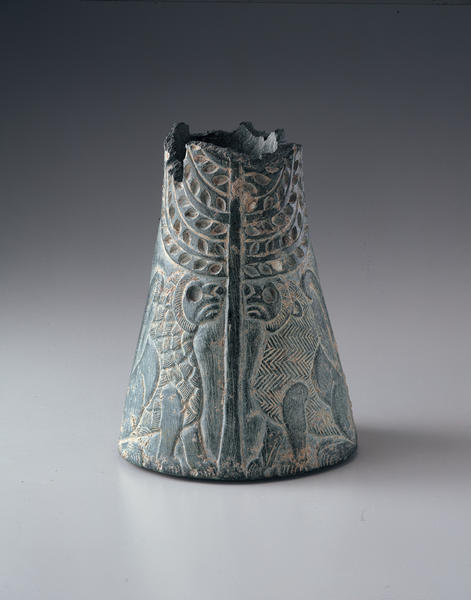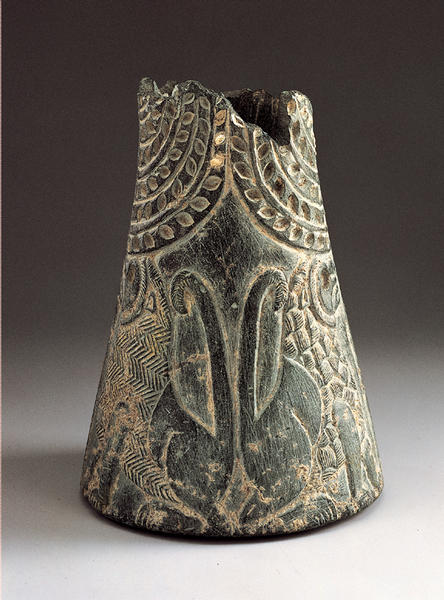獅子文様壺
- イラン東部/バクトリア地方
- 紀元前3千年紀後期
- 緑泥片岩、トルコ石象嵌
- H-20 D-14
職人遊牧民とも呼ばれる当時の東イランの民族は資源の豊富な中央アジアの材料を加工することをも生業とした。彼らの制作したこの種の壷はメソポタミア、中央アジア、ペルシャ湾岸地域など古代オリエント世界で広く交易され、その精緻な細工意匠は「国際様式」と呼ばれている。
この作品は緑泥岩を円錐台形の器にくりぬいて作られ、器外壁には双獅子が聖樹をはさんで向き合っている姿が彫り込まれている。樹木の部分に穿たれた紡錘形の穴には、今では白く変じたトルコ石が嵌め込まれており、生命力あふれる聖樹の葉を鮮やかな青い石で表現したものであろう。しかしこの双獅子表現は硬く、その鬣は襟巻きのような部分を含め大変様式化したものになっているのは、南、東イランといったおそらくライオンとあまり馴染みのない地域の職人が手がけたことを予想させる。この類の壷はメソポタミアの神殿宮殿址、王墓などから発見されており、南イランでは墓からのみ見つかっている。このことから想像するとこの美麗な器は葬儀や神殿の儀式に関連していたのであろう。
古代の交易について
紀元前3500年頃農業の生産力の向上を背景として、メソポタミアとエジプトで古代都市文明があいついで興ったと言われていますが、メソポタミアには鉱物資源が存在しないため古くからそれをイラン高地やその東に続く中央アジアに求めました。
特に中央アジア高地、アフガニスタン北部のバダフシャンやその東のヒンドゥクシュから産する純度の高い準貴石(ラピスラズリ、紅玉髄)は古代オリエント世界で多くの需要があり、遠くはエジプト、小アジアまでもたらされたのです。
またそれを中継して加工品を供給したのが東イラン・ケルマン地方であったと考えられています。この紀元前三千年紀に於て、このイラン高地の遊牧民族は特殊な存在であって、「職人遊牧民」とも呼ばれています。
・Pierre Amiet/ The Period of Irano-Mesopotamian Contacts/ in 'Early Mesopotamia and Iran: Contact and Conflict 3500-1600 BC' ed.J.Curtis London 1993
この器の様式について
この壺は緑泥岩を削ったもので、外側の文様は樹木に向獅子が浮彫りであらわされています。樹木の葉は紡錘型の穴に、今は殆ど失われていますが、トルコ石が象嵌されていました。
穴の内面はトルコ石がよく接着されるための掻き傷がつけられています。向獅子のたてがみの文様は二種類ありますが樹木の葉とともに、手のかかった細工です。
ケルマンからアフガニスタンに至る東イランの紀元前三千年紀頃にこのような一種の標準化された質を持った”ブランド”品が制作され、おそらくラピスラズリロードとほぼ同様の経路をとって、メソポタミア、シリア、ペルシャ湾岸地域の首長、貴族クラスへと交易され、最終的には神殿に奉納されたものと思われます。
この器の精緻な意匠を国際様式<inter cultural style>と呼んでいます。
・C.C.Lamberg-Karlovsky & Maurizio Tosi/ Shahr-i Sokhta and Tepe Yahya: Tracks on the Earliest History of the Iranian Plateau/ East and West 1973;
・Philip L.Kohl/ A Note on Chlorite Artefacts from Shahr-i Sokhta/ East and West 27 1977
ライオンの図像について
ここに表現されている獅子の意匠は現実味からは程遠く、この作品が獅子の生息地域とは異なった由来のものであることを示しています。
ユーフラテス川中流域ではライオンの分布が見られ、アッシリアの時代には盛んにライオン狩が行われましたが、南メソポタミアにはライオンについての言及が少なく、分布は比較的少なかったと考えられます。
東イランの場合はその図像は大変様式化していることから実際的な分布は少なかったものと想像されています。
・Jeremy Black and Anthony Green/ Gods, Demons and Symbols of Ancient
Mesopotamia/ 1992 Austin
・Ancient Art from the Shumei Family Collection/ 1996 New York
古代の文化圏
紀元前三千年紀頃から南イランにエラム王国が興り、このアフガニスタン、東イランの鉱石原料や加工品のメソポタミアへと至る交易を支配しました。
エラムはメソポタミア.シュメールと密接な影響関係があり、またイラン高原、更に中央アジアに至る広範な地域がその文化圏の後背地であったと考えることが出来ます。
・Pierre Amiet/ The Period of Irano-Mesopotamian Contacts/ in 'Early Mesopotamia and Iran: Contact and Conflict 3500-1600 BC' ed.J.Curtis London 1993
婦人座像
鋸壁文円筒杯
牡牛像形分銅
農耕饗宴図杯
ラピスラズリロード
古代中央アジアで産出したラピス・ラズリがエジプトの神像に使われていた事は、当時すでにオリエント世界に広範な交易が存在した事を示しています。
エジプトではすでに紀元前4000年紀後半(3,500~3,000 B.C.頃)には彼の地では産しないラピスラズリを使った宝飾品が出現していますが、少なくとも紀元前三千年紀には、東はインダスの河谷地域からメソポタミアを中継し、西はエジプトに至る、いわゆるラピス・ラズリ=ロードと呼ばれる交易路が存在したと考えられています。
・Horst Klengel/ Handel und Haendler im alten Orient/ 1983 Leipzig
(古代オリエント商人の世界 江上波夫、五味亨訳 山川出版社 1983)
婦人座像
鋸壁文円筒杯
牡牛像形分銅
農耕饗宴図杯
Catalogue Entry
This stone vessel--now broken--narrows as it rises, displaying two pairs of seated lions in low relief, each pair flanking a simple tree with curving, symmetrical branches. Although the stance and the flat, linear style of each lion are virtually identical, the creatures differ in the patterns given to their heavily furred forequarters. On one side the tufted pattern resembles basketwork, while the felines opposite bear a horizontally worked herringbone design. The large, round eyes of each cat were once inlaid, as were the pointed oval leaves of the trees. Several of the leaves still retain their now-pale stone filling. Recent analysis of the damaged surface of one inlay reveals that the stone is turquoise, indicating that the vessel, in its undamaged state, originally was characterized by a vibrant polychromy.
Carved chlorite vessels have been excavated from sites in Mesopotamia and in Central Asia, as well as along the Persian Gulf, for over half a century. The material and the style of carving set these works apart from locally produced stone objects, but their place of manufacture remained unknown. We now know that some of these bowls and vases were produced in eastern Iran and perhaps in northern Afghanistan (ancient Bactria). Excavations at Tepe Yahya in southeastern Iran have revealed one production center,1 and others undoubtedly await discovery. Unfortunately, none of the fragmentary vases recovered from Tepe Yahya exactly parallels the Shumei vessel in shape and decoration. Closer in form and general style are broken vases uncovered at Nippur in Mesopotamia and at Mari on the Euphrates River, between Mesopotamia and Syria2--exotic exports that traveled far from their place of origin. The lions on the Shumei vase are an indication that this vessel, too, was made for the Mesopotamian market, as the heavy-maned western Asiatic lion was unknown on the Iranian plateau and in the Central Asian uplands. This unfamiliarity with the living species may explain the artificial rendering of the lions' manes.
TSK
1. See Metropolitan Museum 1996, p. 10, fig. 1; Lamberg-Karlovsky and Kohl 1971, pp. 15-18.
2. See Orthmann et al. 1975, p. 185, pl. 76a,b.

